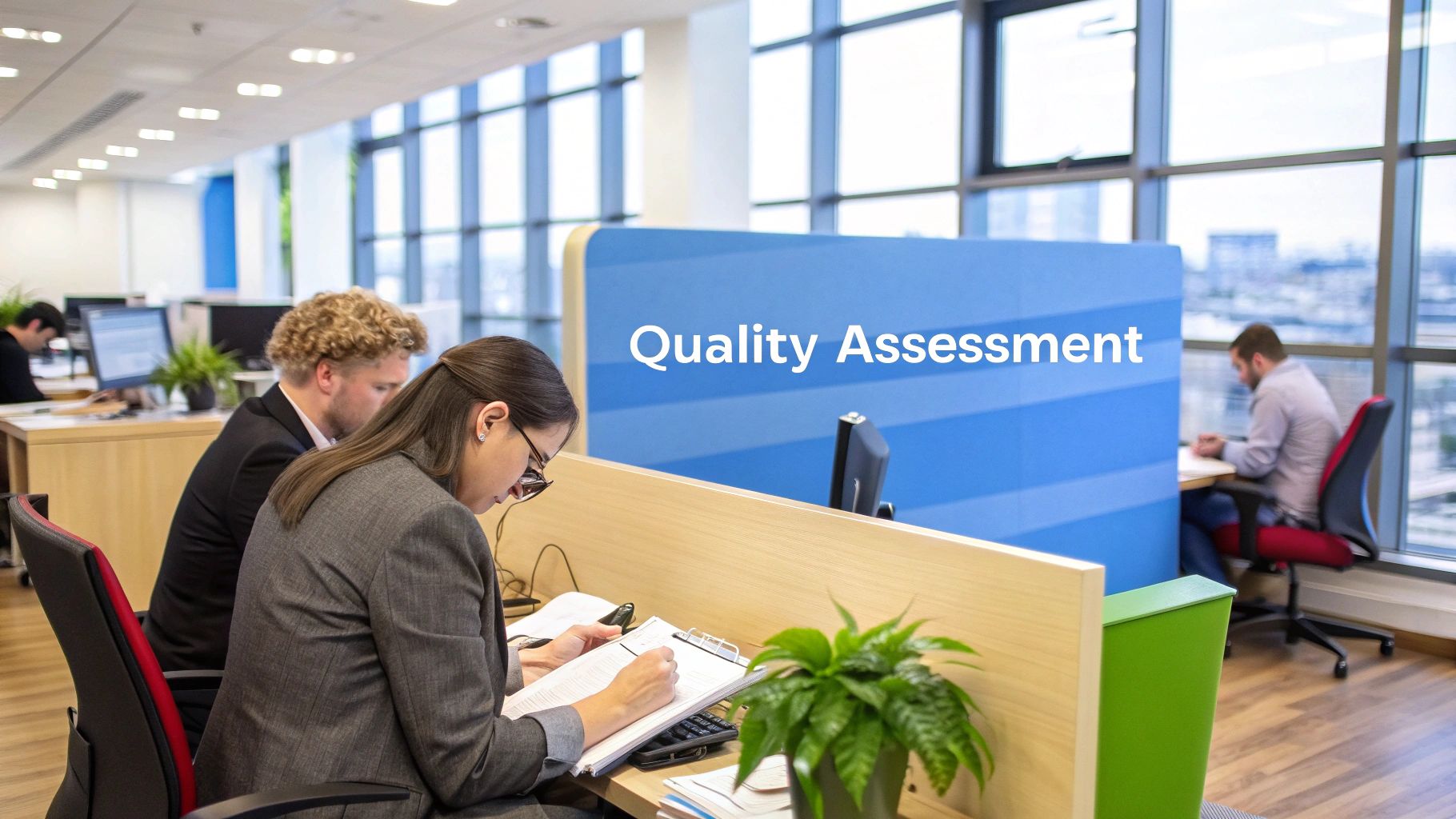Quality Assurance Process Improvement: A Practical Guide for Modern Organizations
Breaking Down Quality Assurance Fundamentals

Quality assurance has evolved beyond simple checks into an ongoing process focused on preventing issues before they occur. Companies now build quality standards directly into their workflows, making it an integral part of everything from how products are developed to how customers are served. This preventive approach helps catch and address potential problems early, saving time and resources.
Key Principles of Effective Quality Assurance Process Improvement
Understanding the core elements of quality assurance helps teams create effective programs that deliver real results. Here are the key principles that form the foundation:
-
Customer Focus: Quality standards must align with what customers actually need and want. For instance, if customers consistently report issues with how long a product lasts, the quality team needs to focus their efforts on improving durability through better materials or design changes.
-
Process Approach: Clear steps and responsibilities help teams work together smoothly. When everyone knows their role and follows established procedures, it’s much easier to maintain consistent quality throughout a product’s development and launch.
-
Data-Driven Decision Making: Numbers tell the real story about quality performance. By tracking specific metrics, teams can spot problem areas quickly, see if their solutions are working, and measure progress toward quality goals.
-
Continuous Improvement: Quality work is never truly finished - there’s always room to do better. Regular reviews and updates to processes help teams keep raising their standards and fixing issues as they come up.
Practical Implementation of Quality Assurance
Turning these principles into action requires specific tools and methods that teams can use every day:
-
Standard Operating Procedures (SOPs): Think of SOPs as detailed recipes - they spell out exactly how to complete important tasks correctly every time. When everyone follows the same steps, there’s less room for mistakes and confusion.
-
Root Cause Analysis: Instead of just fixing surface problems, teams dig deeper to find and fix what’s really causing issues. This prevents the same problems from happening again and again.
-
Quality Audits: Regular checks help spot what’s working well and what needs attention. These reviews give teams clear direction on where to focus their improvement efforts.
Using software tools can make quality assurance work much more efficient. The right tools help automate repetitive tasks and reduce human error, giving teams more time to focus on solving complex problems. For more insights on modern quality practices, check out: Elevating Quality Assurance Beyond Testing to Ensure Superior Software Delivery. By combining proven methods with smart technology choices, companies can build quality systems that consistently deliver better products and services.
Mastering Statistical Process Control That Makes Sense

Quality assurance becomes much more effective when you add statistical process control (SPC) to your toolkit. Rather than getting lost in complex statistics, SPC gives you practical ways to spot and fix quality issues before they affect your products. By tracking key metrics over time, you can move from simply reacting to problems to preventing them entirely.
Understanding the Power of Control Charts
Control charts act like a vital signs monitor for your manufacturing processes. Just as a heart monitor shows a patient’s pulse, these visual charts display how your processes are performing moment by moment. They help you distinguish normal ups and downs from genuine problems that need attention. For instance, if defect rates suddenly jump higher than usual, it could signal equipment problems or issues with raw materials. But small random variations within normal limits are typically nothing to worry about. Being able to tell the difference helps you focus improvement efforts where they’ll have the most impact.
Capability Analysis: Measuring Process Potential
While control charts show if a process is stable, capability analysis reveals whether it can consistently meet customer requirements. This helps you spot potential problems before they affect customer satisfaction. According to a study by the American Society for Quality, companies that effectively use quality management tools like capability analysis see up to 26% higher profits. The message is clear - monitoring process stability isn’t enough. You also need to know if your processes can reliably deliver the quality customers expect.
Choosing the Right Statistical Tools for Your Needs
Different quality challenges call for different statistical tools. The key is picking the right one for your specific situation and data:
- X-bar and R charts: Perfect for measuring variables like length, weight or temperature. These track both average values (X-bar) and the spread of measurements (R) to give you the full picture.
- P charts: Best for pass/fail data, showing what percentage of items have defects. These work well for tracking reject rates.
- C charts: Used to count defects when checking the same sample size each time. Great for spotting trends in defect counts.
Selecting the most suitable chart type helps you extract meaningful insights from your data. This leads to smarter decisions about process changes, resource allocation, and quality improvements. The end result? More efficient quality management driven by real data rather than guesswork.
Making Quality Improvements Pay Off
Quality improvements directly impact your bottom line - but how exactly do they translate into financial gains? While tools like statistical process control help identify problems, the key is showing how fixing these issues creates real value. This means going beyond just spotting problems to measuring their financial impact and demonstrating clear returns on quality investments.
Calculating the True Cost of Quality Issues
When quality problems occur, their costs ripple far beyond just fixing defective products. A single defect can trigger expensive recalls, damage your brand’s reputation, and break customer trust - all of which hit revenue hard. Inside your operation, you’re also losing money on wasted materials, extra work hours spent on fixes, and scrapped products. By adding up both the obvious and hidden costs, you get a clear picture of what quality issues really cost. This detailed cost analysis helps justify spending on quality improvements to leadership.
Building a Business Case for Quality
With solid cost data in hand, you can create a compelling case for quality initiatives. Show how better quality directly boosts profits through lower production costs and higher customer satisfaction. Better quality means fewer returns and complaints, which leads to repeat business and word-of-mouth referrals. Quality programs also help companies stay compliant with regulations and avoid costly penalties. Present these benefits clearly to decision makers to secure resources for your quality improvement efforts.
Measuring the ROI of Quality Investments
To maintain support for quality programs, track and report their returns consistently. Focus on metrics that matter: defect rates, customer complaints, production cycle times, and on-time delivery. Monitor these numbers carefully to show how your quality efforts pay off. Regular updates on improvements help justify continued investment in quality initiatives.
Strategies for Quick Wins and Long-Term Growth
While building lasting quality takes time, you can gain momentum with early wins. Start by fixing obvious problems that have simple solutions - like reorganizing a bottleneck work station or updating outdated inspection methods. These quick improvements build support for bigger changes later. At the same time, work on making quality part of your company culture. Train employees to spot and solve quality issues, encourage open discussion of problems, and provide ongoing learning opportunities. This mix of short-term fixes and long-term culture change helps maximize the financial benefits of your quality program.
Implementing ISO 9001 Without the Headaches

Getting ISO 9001 certification often feels overwhelming - mountains of paperwork, rigid procedures, and worries about stifling your company’s growth. But it doesn’t have to be this way. With the right approach, you can build a quality management system (QMS) that actually makes your operations run more smoothly while encouraging real improvement.
Simplifying Documentation and Processes
Many organizations dread the documentation requirements of ISO 9001. The key is changing how you think about documentation. Well-written procedures aren’t just paperwork - they’re valuable tools that clarify who does what, establish consistent ways of working, and preserve important company knowledge. For instance, clear standard operating procedures (SOPs) help train new employees and ensure everyone follows the same reliable process. Using digital tools for documentation makes it even easier by cutting down on physical paperwork, automating workflows, and tracking document versions. This means less time shuffling papers and more time focused on real improvements.
Building a Culture of Ongoing Improvement
ISO 9001 goes far beyond just ticking boxes on a checklist. Success comes from getting everyone involved in spotting problems and suggesting better ways of working. Internal audits work best when treated as opportunities to find and fix weak spots, not as gotcha moments. When people feel comfortable raising issues early, you can solve small problems before they become big headaches. The results speak for themselves - companies with ISO 9001 certification typically see fewer defects and happier customers. This happens because everyone starts thinking about quality as part of their daily work.
Growing While Staying Compliant
Many worry ISO 9001 will slow down innovation, but the opposite is often true. A solid QMS gives you a framework for trying new things while maintaining quality. You can measure the impact of changes and make decisions based on real data. For example, when launching a new product, your QMS helps ensure proper testing and validation without cutting corners. This structured approach to innovation helps you meet customer needs and regulatory requirements from the start.
Making ISO 9001 Work for Your Business
The real power of ISO 9001 comes from matching it to your specific business needs. Rather than just following rules, focus on using the standard to support your company’s goals. Understanding how the requirements apply to your industry lets you build processes that make sense for your situation. This practical approach turns ISO 9001 from a bureaucratic exercise into a valuable tool for running your business better, serving customers well, and staying ahead of competitors.
Building a Culture of Continuous Improvement

Quality assurance isn’t just about following procedures - it’s about creating an environment where everyone actively works to make things better. When quality improvement becomes part of your company’s DNA, it creates lasting positive change that shows up in better products, satisfied customers, and stronger business results. Let’s explore how to make this happen.
Engaging Employees at All Levels
Getting everyone involved is key to successful quality improvement. The people doing the actual work often notice problems and opportunities that managers miss. For instance, assembly line workers might spot ways to reduce defects, while customer service staff understand common user complaints. By giving these employees clear channels to share their ideas and actually implementing good suggestions, you build trust and motivation. Simple recognition programs, like monthly quality awards or sharing success stories in team meetings, show that quality matters at every level.
Implementing Effective Feedback Systems
Good feedback systems help teams spot and fix problems quickly. Regular check-ins with both employees and customers through surveys, interviews, and casual conversations provide valuable insights. But collecting feedback is just the start - you need a clear process to review it, identify patterns, and take action. For example, if multiple customers report similar issues, that feedback should trigger a review of the related processes. When people see their input leading to real changes, they’re more likely to keep sharing their thoughts and ideas.
Maintaining Momentum in Improvement Initiatives
Making lasting changes takes time and consistent effort. Instead of trying to fix everything at once, break improvements into smaller steps that teams can tackle one at a time. This might mean focusing on one production line or process for a few weeks before moving to the next. Celebrate small wins along the way - like reducing errors by 10% or completing training programs. Regular team meetings to share progress and discuss next steps keep everyone focused on continuous improvement.
Overcoming Resistance to Change
People naturally resist change, especially when they’re comfortable with current ways of working. The key is showing how changes make work easier or better. For example, if you’re introducing new quality checks, demonstrate how they prevent time-wasting rework later. Include team members in planning changes - they often have practical suggestions that make new processes work better. Hold open discussions where people can voice concerns and ask questions. When teams feel heard and involved in changes, they’re more likely to support them. This open approach builds trust and reinforces that quality improvement is everyone’s responsibility.
Measuring What Actually Matters in Quality
Understanding which metrics drive real progress is essential for improving quality assurance processes. Rather than gathering data for its own sake, teams need to focus on specific measurements that connect directly to business goals and guide concrete improvements.
Defining Your Quality Objectives
Start by getting crystal clear on what you want to achieve with your quality program. Are you trying to catch more defects before release? Make customers happier? Speed up your development cycle? Your specific aims will determine which metrics make sense to track. For example, if reducing customer issues is the priority, you’ll want to closely monitor product returns, negative feedback, and support requests. This targeted approach keeps measurement efforts focused on what delivers real value.
Key Performance Indicators for Quality Assurance Process Improvement
After setting clear objectives, select metrics that will help you assess progress. Here are some tried-and-tested options:
- Defect Rate: Track the percentage of products or services with issues - lower numbers mean your quality processes are working better
- Customer Satisfaction: Gather feedback through surveys, forms and reviews to gauge how well you’re meeting user needs
- Cycle Time: Measure how long processes take from start to finish - shorter times often mean better quality and efficiency
- First Pass Yield: Calculate what percentage passes inspection initially - higher numbers indicate stronger process controls
- Cost of Quality: Add up prevention costs plus the expense of fixing issues that slip through - reducing this improves the bottom line
While not comprehensive, these core metrics provide a solid foundation. Choose the ones that best fit your industry and goals. For more insights specific to software testing, check out: Essential Metrics for Software Testing.
Data Collection and Analysis
Getting accurate data requires a mix of approaches - automated tracking, manual checks, and direct customer input all play a role. Look for patterns in the numbers using tools like control charts and trend analysis. This reveals concrete ways to strengthen your quality processes.
Reporting and Continuous Improvement
Share results openly with everyone involved - managers, staff, and customers. Simple visuals like charts help communicate complex findings clearly. Most importantly, use what you learn to make real changes. When the data shows room for improvement, adjust your approach. This cycle of measuring, analyzing and enhancing processes helps build lasting quality improvements that benefit the whole organization.
Boost your testing efficiency and ensure software quality with GoReplay. Capture and replay real HTTP traffic, simulate real-world scenarios, and identify potential issues before they impact your users. Learn more at https://goreplay.org.
